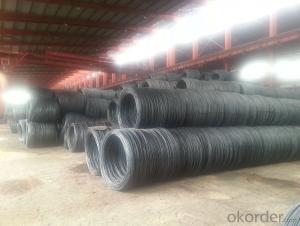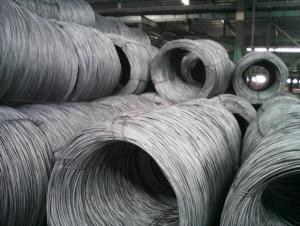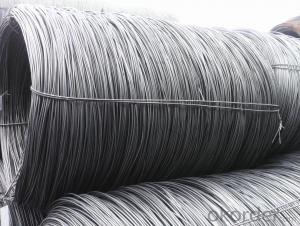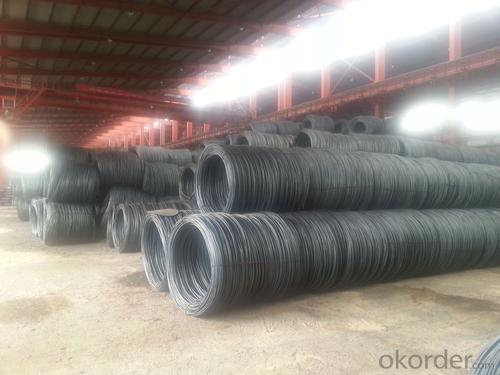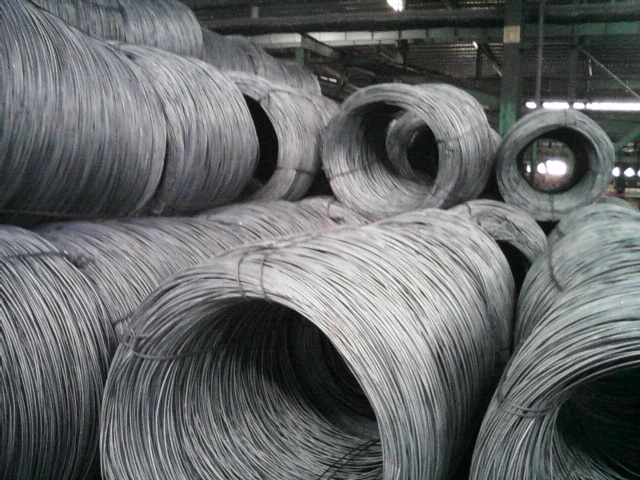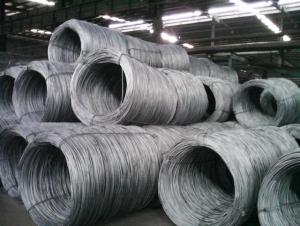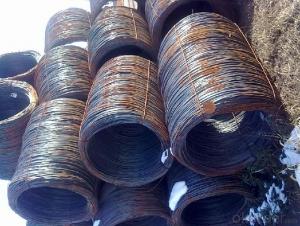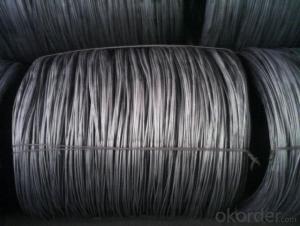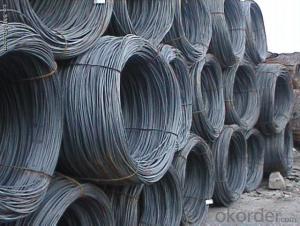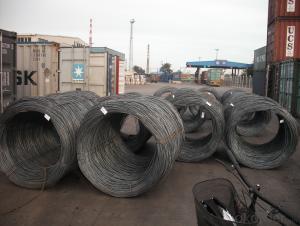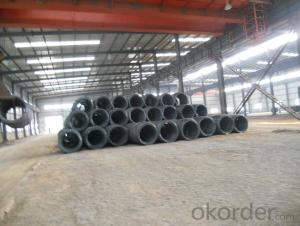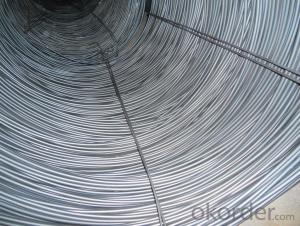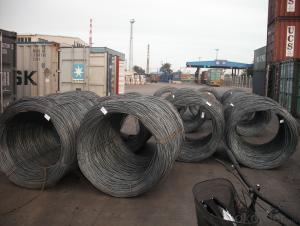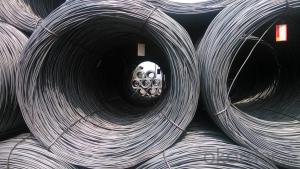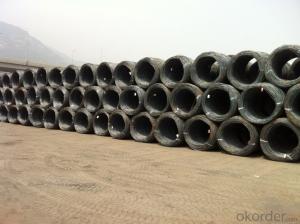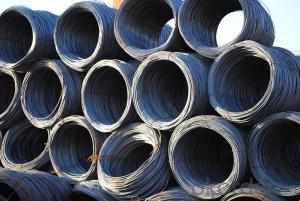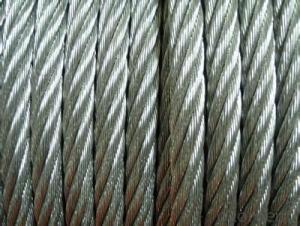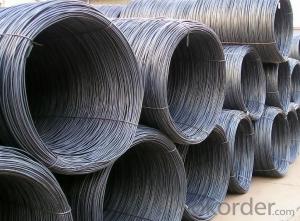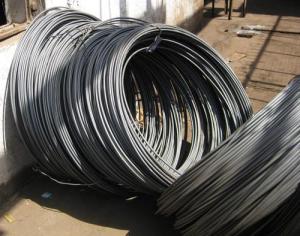Hot Rolled Carbon Steel Wire Rod in Coil
- Loading Port:
- China Main Port
- Payment Terms:
- TT or LC
- Min Order Qty:
- -
- Supply Capability:
- -
OKorder Service Pledge
OKorder Financial Service
You Might Also Like
Product Description:
OKorder is offering Wire Rod at great prices with worldwide shipping. Our supplier is a world-class manufacturer of steel, with our products utilized the world over. OKorder annually supplies products to European, North American and Asian markets. We provide quotations within 24 hours of receiving an inquiry and guarantee competitive prices.
Product Applications:
After hot-rolled the products shaped into coil and delivery as finished product, including round, square, rectangular, hexagonal and so on. Since most of the products are round, it is generally called wire rod. Carbon steel wire rod is widely used in construction and manufacturing. Carbon steel wire rod is mainly used for reinforcement of reinforced concrete and welded structure or reprocessed (roberts , nail, etc.) materials, especially used to produce wire drawing, welding electrode, nails, spring, electronic, precise machinery parts and so on.
Product Advantages:
OKorder's Wire Rod are durable, strong, and resist corrosion.
Main Product Features:
· Premium quality
· Prompt delivery & seaworthy packing (30 days after receiving deposit)
· Corrosion resistance
· Can be recycled and reused
· Mill test certification
· Professional Service
· Competitive pricing
Product Specifications:
Steel Grade: Q195/235, SAE1006-1018B Standard: ASTM, GB
Diameter: 5.5mm, 6.5mm, 7mm,8mm,9mm,10mm,12mm,14mm
Type: in coil, coil weight around 2MT Alloy or Not: Alloy
Surface: round, no twisted, light and smooth Chemical Composition: (Please kindly find our chemistry of our material based on Q195、Q235A and Q235B as below for your information)
Grade | Chemical Composition (%) | |||||
C | Mn | S | P | Si | B | |
SAE1008B | 0.10max | 0.32max | 0.045max | 0.040max | 0.30max | 0.0008min |
Mechanical properties | ||||||
Yield strength(N/mm2) | Tensile strength(N/mm2) | Elongation (%) | ||||
≥195 | 350-380 | ≥32 | ||||
Note:
1. Our products are produced according to national standard (GB), if not, supply according to national standards (GB) or agreement as customer required.
2. Other Grade and Standard carbon steel wire rod we can supply:
Grade: H08A, 30MnSi, 62B-82B
Standard: AISI, BS, JIS, DIN
The Minimum Order Quantity of these products is high, and need to be confirmed.
3. We can not only supply carbon steel wire rod; if you need anything about building materials, please contact us.
4. Please send us your detail specifications when inquire. We will reply to you as soon as possible. We sincerely hope we can establish a long stable business relationship.
FAQ:
Q1: How soon can we receive the product after purchase?
A1: Within three days of placing an order, we will begin production. The specific shipping date is dependent upon international and government factors, but is typically 7 to 10 workdays.
Q2: How do we guarantee the quality of our products?
A2: We have established an advanced quality management system which conducts strict quality tests at every step, from raw materials to the final product. At the same time, we provide extensive follow-up service assurances as required.
Q3: Can stainless steel rust?
A3: Stainless does not "rust" as you think of regular steel rusting with a red oxide on the surface that flakes off. If you see red rust it is probably due to some iron particles that have contaminated the surface of the stainless steel and it is these iron particles that are rusting. Look at the source of the rusting and see if you can remove it from the surface.
Images:
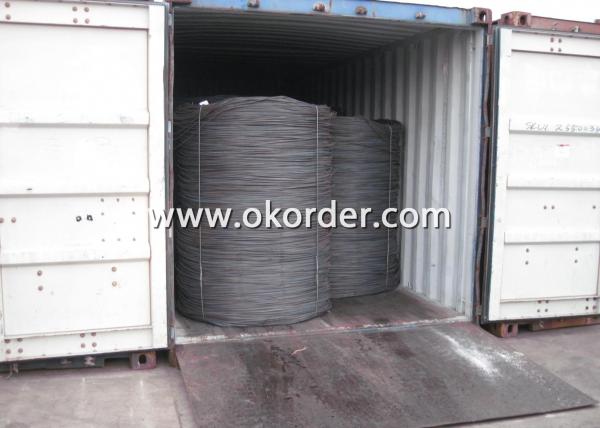

- Q: What are the main trade associations and organizations in the steel wire rod industry?
- Some of the main trade associations and organizations in the steel wire rod industry include: 1. American Wire Producers Association (AWPA): This trade association represents the interests of wire producers, suppliers, and consumers in North America. They work towards promoting the use of wire products and advancing the industry through advocacy, education, and networking. 2. International Wire & Machinery Association (IWMA): IWMA is a global association that brings together wire and cable manufacturers, suppliers, and machinery companies. They organize events, conferences, and exhibitions to facilitate networking and knowledge sharing among industry players. 3. Wire Association International (WAI): WAI is a non-profit association dedicated to promoting the interests of the wire and cable industry worldwide. They offer technical resources, training programs, and industry updates to their members, fostering collaboration and innovation in the steel wire rod sector. 4. International Iron and Steel Institute (IISI): While not specific to the wire rod industry, IISI represents the global steel industry, including producers, distributors, and other stakeholders. They provide a platform for industry collaboration, policy advocacy, and information exchange. 5. Steel Wire Manufacturers Association (SWMA): SWMA is a trade association that represents wire manufacturers in the United States. They advocate for fair trade practices, provide technical expertise, and promote the use of wire products in various industries. These organizations play a crucial role in advancing the steel wire rod industry by providing a platform for collaboration, knowledge sharing, and advocacy. They contribute to the growth and development of the industry while ensuring the sustainability and competitiveness of its members.
- Q: How is steel wire rod used in the production of electrical cables?
- Steel wire rod is used in the production of electrical cables as it serves as the core strength component. It provides structural support and enhances the durability and tensile strength of the cable. The steel wire rod is typically wrapped around the conductor and acts as a protective layer, preventing the cable from stretching or breaking under tension. Additionally, it helps to maintain the shape and integrity of the cable, ensuring reliable transmission of electricity.
- Q: What are the common applications of low alloy and oil tempered steel wire rod?
- Various industries commonly utilize low alloy and oil tempered steel wire rod due to its wide range of applications. One such application is found in the manufacturing of automotive components. These steel wire rods are essential for producing springs, including suspension springs and valve springs, which play a crucial role in ensuring the proper functioning of vehicles. Their exceptional strength and durability make them well-suited for enduring the demanding conditions and heavy loads experienced by automobiles. Additionally, the construction industry relies on low alloy and oil tempered steel wire rod for a multitude of purposes. Reinforcing bars, also known as rebars, are fabricated from these steel wire rods and are indispensable for reinforcing concrete structures such as buildings, bridges, and highways. The strength and ductility of these steel wire rods guarantee that the reinforced structures can withstand the stresses and pressures they encounter, thereby providing stability and longevity. Moreover, low alloy and oil tempered steel wire rod finds extensive application in the manufacturing of various industrial equipment and machinery. Wire ropes, commonly used in cranes, elevators, and other lifting equipment, are frequently made from these steel wire rods. Their high tensile strength and resistance to corrosion make them suitable for withstanding heavy loads and harsh environments. Furthermore, low alloy and oil tempered steel wire rod is also utilized in the production of wire mesh, fencing, and other wire products. The strength and durability of these steel wire rods ensure that the wire products can endure external forces and provide security or containment in diverse settings, such as construction sites, agricultural fields, and industrial facilities. Overall, low alloy and oil tempered steel wire rod is widely employed in the automotive, construction, industrial, and wire product sectors. Its unique properties, including high strength, durability, and resistance to corrosion, make it a versatile material that contributes to the functionality and reliability of various products and structures.
- Q: How is the steel wire rod industry affected by government policies and regulations?
- The steel wire rod industry is significantly impacted by government policies and regulations. These policies and regulations can influence various aspects of the industry, including production, trade, pricing, and environmental standards. Governments may impose tariffs or quotas on steel wire rod imports to protect domestic producers, which can affect the competitiveness of the industry. Additionally, regulations related to labor, safety, and environmental standards can influence the operations and costs of steel wire rod producers. Government policies and regulations also play a crucial role in supporting the growth and development of the industry, such as providing incentives for research and development, infrastructure development, and promoting sustainable practices. Overall, the steel wire rod industry is highly dependent on government policies and regulations, which can shape its competitiveness, sustainability, and overall performance.
- Q: How is the diameter of steel wire rod measured?
- To determine the diameter of a steel wire rod, one commonly employs a micrometer, a specialized precision measuring instrument. This device is specifically crafted to achieve precise measurements of small distances or thicknesses. Comprising a calibrated screw mechanism paired with a spindle, the micrometer is meticulously manipulated until it delicately makes contact with the wire rod's surface. The resulting measurement is subsequently read from the micrometer's scale, which frequently incorporates both metric and imperial units. By employing this technique, one guarantees precise and uniform determination of steel wire rod diameters.
- Q: How is the inclusion content of steel wire rod determined?
- The inclusion content of steel wire rod is determined through various methods such as microscopic examination, chemical analysis, and the use of specialized equipment. These techniques allow for the identification and quantification of any impurities or non-metallic inclusions present in the steel wire rod.
- Q: How are steel wire rods stored to prevent corrosion?
- To minimize exposure to moisture and air, which are the main factors leading to corrosion, steel wire rods are typically stored. To prevent corrosion, the rods are commonly kept in a dry and well-ventilated area, far from coming into direct contact with the ground or any potential sources of moisture like water pipes or damp walls. Often, they are placed on pallets or racks, permitting proper airflow and avoiding contact with any surface that might contain water or excessive humidity. Moreover, a protective layer such as oil or a rust preventive compound is often applied to the steel wire rods to provide additional protection against corrosion during storage. It is also crucial to conduct regular inspections and maintenance to ensure that the storage conditions remain optimal and promptly address any signs of corrosion.
- Q: How is steel wire rod used in the production of wire mesh for oil and gas filtration?
- Steel wire rod is used as the primary material in the production of wire mesh for oil and gas filtration. The wire rod undergoes a series of processes, including drawing, annealing, and coating, to enhance its strength and corrosion resistance. Once transformed into wire, it is woven or welded to create a mesh structure that effectively filters out impurities and contaminants from oil and gas. The resulting wire mesh is durable, efficient, and capable of withstanding high temperatures and harsh operating conditions, making it a vital component in oil and gas filtration systems.
- Q: What is the composition of a steel wire rod?
- The primary composition of a steel wire rod consists of iron and carbon, along with small amounts of other elements like manganese, silicon, and sulfur. Iron, being the main component, imparts strength and durability to the wire rod. Carbon is added to enhance the steel's hardness and tensile strength, thereby making it suitable for diverse applications. Manganese improves the overall strength and ductility of the wire rod, while silicon aids in enhancing its corrosion resistance. Sulfur is typically present in minimal quantities to facilitate the steel's machinability during the manufacturing process. The specific composition of a steel wire rod may vary depending on the desired properties and intended use.
- Q: What are the main factors influencing the choice of steel wire rod order cancellation policy?
- The main factors influencing the choice of steel wire rod order cancellation policy include market conditions, supply and demand dynamics, contractual agreements, financial implications, and customer relationships.
Send your message to us
Hot Rolled Carbon Steel Wire Rod in Coil
- Loading Port:
- China Main Port
- Payment Terms:
- TT or LC
- Min Order Qty:
- -
- Supply Capability:
- -
OKorder Service Pledge
OKorder Financial Service
Similar products
Hot products
Hot Searches
Related keywords
